When Meretz, Ehud Barak’s Israel Democratic Party, and Labor’s Stav Shaffir created the Democratic Union, Nitzan Horowitz became the new leader of the Israeli left. Although these factions merged in order to ensure the left’s survival, the Democratic Union’s birth has also given the left a burst of energy it has not seen since Ratz, Mapam, and Shinui aligned to form Meretz itself in 1992. ‘The era of kowtowing to the right’ says Horowitz, ‘is over.’
1.
Anshel Pfeffer compared the politicians in the photograph to three people clinging to a life raft. On the left, Ehud Barak, Israel’s former prime minister who, on 26 June, announced his re-entry into the political arena as the head of the new Israel Democratic Party. In the centre, holding a camera (if not the camera, as the photo is of three people posing for a selfie), Stav Shaffir, who came of age during the 2011 social justice protests and, as part of the Labor Party, made her mark in the Knesset as an active parliamentarian with a focus on transparency and corruption. And on the right, Nitzan Horowitz, who completed his dramatic return from the political wilderness the day after Barak announced his own comeback by winning Meretz’s leadership primary.
Barak resumed electoral politics stressing the need for the parties of the left and centre to form a joint list before the upcoming September vote – under his leadership, of course. In the end, however, that was not quite how things transpired. Barak, Shaffir, and Horowitz posed together on 25 July in order to declare the formation of the Democratic Union, a political alliance made up of Barak’s Israel Democratic Party, Meretz, the Green Movement, and Shaffir, to be led not by Barak but Horowitz.
Perhaps the Democratic Union is indeed a life raft. For Barak, it offers the possibility that his return to the frontline need not have been in vain – or better yet, need not become an embarrassment, given polling had indicated that there was no guarantee his Israel Democratic Party would make it over the 3.25 per cent threshold. Shaffir, meanwhile, had found herself blocked inside Labor, having come second to party veteran Amir Peretz in this year’s leadership primary. Peretz subsequently formed an electoral alliance with Orly Levy-Abekasis, meaning Labor will be competing in September in the already-overcrowded political centre, even though figures including Shaffir were pushing the party to take heed of Barak’s call for an alliance of the left. Her new role in the Democratic Union offers either a respite for Shaffir and the option to return to Labor at a later date, or a new route to a leadership position inside her adopted political home.
For Horowitz, though, it is not entirely clear that the Democratic Union constitutes a life raft at all. In some sense, it is a means to an end, a structure that will ensure votes aren’t wasted and misdirected and that Meretz, as such, will be represented in the next Knesset. But if any one politician can be said to have gained from the creation of the Democratic Union, it is Horowitz, for he now, perhaps unexpectedly, finds himself leading a union of left-wing parties and individuals that will act as a locus for secular voters who are socially liberal, economically social democratic, and absolutely anti-Netanyahu, the likes of which has not been seen since Ratz, Mapam, and Shinui came together in 1992 to create Meretz itself.
‘If this column had predicted a week ago,’ Yossi Verter wrote 26 July after the creation of the Democratic Union, ‘that we would find Barak in the 10th slot on the Meretz slate, under the leadership of Nitzan Horowitz, the men in the white coats would have been pounding on Ha’aretz’s doors. Horowitz is the big winner in this story. He displayed impressive political skills, paid a minimal price and created a structure that Meretz hasn’t known for two decades: leading, consolidated, confident.’
2.
Before Horowitz was a parliamentarian, he was a lawyer and a journalist. Armed with a Polish passport in addition to his Israeli one (Horowitz was chair of the Knesset’s Israel-Poland Parliamentary Friendship Group), he worked in print, radio, and television for Israel Army Radio, Ha’aretz, and Channel 10 with a focus on international affairs. After entering the Knesset in 2009, Horowitz became chair of the body’s Committee on Foreign Workers. In 2013, he obtained a place on the Foreign Affairs and Defence Committee, using it as a perch from which to criticise the government’s approach to the Israeli-Palestinian conflict.
That same year, he ran a tough campaign against Ron Huldai in an attempt to become Tel Aviv’s mayor. Horowitz criticised Huldai for turning the city into one for the rich, capturing the mood of the social justice protests that had taken place two years prior in his call for affordable housing and better educational opportunities. Horowitz’s Knesset career, then, balanced his interests in foreign affairs and social issues including LGBT rights. Horowitz was the Chair of the body’s Gay Lobby and, in 2009, became the Knesset’s second-ever openly gay parliamentarian, following in Uzi Even’s wake.
Before the 2015 election, Horowitz retired from the Knesset. Away from frontline politics, he returned to journalism, writing columns for Ha’aretz, and took up a post as policy fellow at Israeli think tank Mitvim, the Israeli Institute for Regional Foreign Policies. There, Horowitz authored among other things a paper assessing the Knesset’s low impact on Israeli foreign policy, noting the body is ‘almost completely absent from domains of thinking, research, planning, decision-making, and decisiveness in international affairs’ and calling for the work of the Foreign Affairs and Defence Committee to be separated into two new bodies, decoupling foreign policy and security issues.
Then, on 10 June, Horowitz announced not only his return to electoral politics but that he would be challenging Tamar Zandberg for the Meretz leadership. Though the incumbent, who led Meretz during the April vote to an underwhelming four seats, called for stability and won the endorsements of the party’s prominent Israeli-Arab lawmaker Issawi Frej and also Mossi Raz, Horowitz nonetheless won the leadership primary by 459 votes to 383. In doing so, Horowitz became the first openly gay leader of an Israeli political party.
3.
Horowitz entered the Knesset when Meretz was at its lowest ebb. Under the leadership of Haim Oron – kibbutznik, Peace Now founder, Mapam stalwart – in February 2009, the party won less than three per cent of the vote and three measly seats. By the time he bowed out in 2015, though the party’s standing had recovered somewhat, Meretz went into that election in survival mode. Covering that vote for Slate, I recall standing at the back of a small bar in Tel Aviv just off of Rothschild Boulevard, watching the party’s then-leader, the indefatigable Zehava Gal-On, her voice strained and hoarse, pleading for every vote, practically begging her core supporters not to desert Meretz in its hour of need for Buji Herzog’s Zionist Union. In 2015, as in 2009 and 2019, the party did just enough to live another day.
The story of the decline of the Israeli left is a belaboured one too often told incorrectly. Rarely is it considered, for example, that while the left did indeed lose the electoral struggle after the turbulent 1990s and bloody Second Intifada, it won the war of ideas. In the 2000s and 2010s, new centrist parties from Kadima to Yesh Atid to Blue and White challenged neither the necessity of the peace process nor Israel’s separation from the Palestinians. Hawks from Ariel Sharon to Tzipi Livni became doves, and when Benjamin Netanyahu endorsed the two-state solution in his 2009 Bar-Ilan speech, it was the culmination of the left’s pyrrhic victory. Thereafter, the argument was not about whether or not to have a peace process, but rather the parameters along which it should be conducted.
The left, thus, by winning the war of ideas, was partly hollowed out, the right and centre having appropriated part of its raison d’etre. Meretz is also the victim of recent moves to raise the electoral threshold, which has led to the creation of political blocs that draw in voters from the left to the centre. In April, Blue and White did not pick off soft right voters so much as cannibalise Labor and Meretz’s support in order to become the largest opposition party. I saw the same thing happen in 2015 when I interviewed voters on Kibbutz Nirim in Israel’s south, many of whom had decided to vote for the Zionist Union as opposed to Meretz in an attempt to build up the opposition bloc.
But Meretz is also partly responsible for its own decline, having made strategic mistakes since its zenith in the 1990s. Meretz has been out of government since 2001, even during times such as Ehud Olmert’s premiership in the mid-2000s, when the ideological conditions were more conducive to its participation. Moran Azulay argues that successive Meretz leaders have all made the same mistake of ‘seeking justice while being excluded from the basis of the political system,’ playing no role in governance while its voters ‘watched all the budgets, decisions and governmental fat being handed over to the Right.’
Observers argue Meretz has also become a party that increasingly talks to itself. Avi Buskila, who left Peace Now in order to run unsuccessfully for Meretz’s party leadership prior to the April 2019 election, argued in 2016 that the Israeli left doesn’t understand the country’s Mizrahi population. ‘The left, in many ways, failed to speak to the people. For years, it just told everyone why they are wrong,’ he said, coming across as a ‘elitist Ashkenazi camp’ that fails to grasp the Mizrahim’s ‘alienation towards government’ and the ‘painful narrative of fear’ prevalent in the Israeli periphery.
Buskila – who identifies as gay – and his failed leadership bid also calls attention to another criticism: that Meretz has surrended ground on its core issues to other parties. This means not only the Israeli-Palestinian conflict, as discussed, but also LGBT rights. As other parties sought to build up their LGBT representation, from Itzik Shmuli in Labor to Idan Roll and Eitan Ginzburg in Blue and White and Amir Ohana in Likud, after Horowitz’s retirement Meretz did not have an LGBT parliamentarian. In April 2019, Buskila was placed eighth on the party list, a position from which he was never likely to enter the Knesset while Meretz’s lacklustre campaign made the party appear valueless. It concentrated its energies on survival, ‘scraping the bottom of the barrel for votes to keep it afloat’, though for what reason, it was not clear.
4.
On the night he won the leadership primary, Horowitz said, ‘Meretz has a clear, straight path, of love for humans, and belief in equality and freedom. This is the path I have walked my whole life and continue to walk. This way of life is under attack and Meretz will fight for freedom for all, from darkness, racism and coercion.’ He added the party was ‘prepared for talks and cooperation based on our values’ and had ‘a historic responsibility to create a strong left.’
From the off, then, Horowitz’s strategy going into this election was to create a strong and unified left opposition in contradistinction to the centre and right, a form of compromise that repudiates the old critique that Meretz had become a party disinterested in coalition. When Amir Peretz won Labor’s leadership contest on 3 July, Horowitz offered to begin talks with him in order ‘to discuss possible cooperation for the success of the Israeli left.’ At the time Meretz finalised its list on 12 July, the party was reportedly locked in talks with Labor and former Hatnua leader Tzipi Livni.
Joshua Davidovich at The Times of Israel called all this more of ‘a throw-everything-at-the-voter-and-see-what-sticks strategy than anything else,’ and indeed, at the heart of Horowitz’s strategy was the consideration that, in order to survive, the left had to unite. Polling indicated a merger would only strengthen the left, ensuring votes did not go to waste. ‘I supported the union on the left because it prevented critical votes on the left from disappearing beneath the electoral threshold,’ former Meretz chairwoman Gal-On wrote recently in Ha’aretz.
But, she continued, she also supported the merger because ‘there is a chance here to see a large leftist party that doesn’t fear its own shadow.’ That second part of the electoral strategy became even clearer, in a sense, after Peretz decided on 20 July to couple Labor with Gesher. ‘Instead of a large merger [of left-wing parties], Peretz chose a small safeguard, turning to the right in the direction of the Netanyahu government,’ Horowitz said. ‘I’m telling opponents of Netanyahu to not waste their breath on Peretz and Orly Levy. They’re going to be the first to desert [the left] for the Netanyahu government. A vote for Labor is a vote for Netanyahu.’
Peretz’s thinking, such as it is, is that his alignment with Gesher moves socio-economic issues to the forefront of Labor’s platform, making the party more appealing to a constituency he feels best placed to tap into: socially-minded Mizrahim. Of course, Peretz tried this once before in March 1999, when he, Rafik Haj Yahia, and Adisu Massala left Labor to form One Nation, a social democratic party which rejected Labor’s Third Way approach to economics. In the May 1999 election, One Nation captured 1.9 per cent of the vote, with it two seats, and by 2005 the party had folded, with Peretz returning to Labor.
Recent polls indicate Labor’s union with Gesher will bring it no benefit whatsoever. In April, it won six seats; it looks set to capture five or six seats in September. The fact remains that changing the voting patterns of Israel’s Mizrahim, which were set in the 1970s and haven’t altered much since, is a generational project, not one that can be achieved by way a political sleight-of-hand. Peretz’s efforts in 1999 failed; his merger with Gesher will likely also prove a fool’s errand. (Indeed, the only winner here may be Levy-Abekasis herself, who had no chance of getting into the Knesset on her own steam and for whom Labor is indeed a life raft, albeit one that is listing rather dangerously.)
Thus, when Horowitz said on 20 July that ‘Now there’s only one party to the left of Blue and White and that is Meretz. We’re the only ones committed to not sitting with Netanyahu, no matter the price,’ he was right. Its agenda is sparse yet simple: ‘a peace deal with the Palestinians on the basis of the two-state solution, not joining a right-wing government, and cancelling the controversial Jewish nation-state law passed last year,’ The Times of Israel reported. Indeed, the Democratic Union will save Meretz and Barak both, but their cooperation makes them more relevant than they would have been apart.
5.
The question raised by Meretz’s leadership primary was not if Meretz should become part of a larger electoral bloc but merely with whom they should partner. Zandberg favoured the idea that Meretz should more clearly define itself as a Jewish-Arab party. But when Horowitz won the contest, it indicated that the members of Meretz’s central committee were more in favour of forging links with other Zionist political parties on the left and centre of the political spectrum. The creation of the Democratic Union, even though it does not include Labor, is the fulfilment of that desire.
Nonetheless, Israel’s Arab voters remain an important consideration in the Democratic Union’s electoral strategy. ‘We are proud leftists,’ Horowitz said when he won the primary, and ‘we need to form alliances with new groups and the heads of Arab and Druze society.’ ‘I asked [Ehud Barak] who the main person was who promoted the merger’ between Meretz and his Israel Democratic Party, Yossi Verter wrote. “Issawi Frej,” he said without hesitation, referring to the Meretz MK. “He’s clearly the best man, more than people think.” Horowitz says the same.’
Frej, the Muslim-Arab MK from Kfar Qasim who has represented Meretz in parliament since 2013, set the creation of the Democratic Union in motion with his 23 July op-ed in Ha’aretz, which called on Barak ‘to apologise to the country’s Arab community for the events of 2000, when the police shot dead 13 demonstrators during Barak’s premiership.’ Frej then ‘moved things along and held vigorous contacts with all sides; without him this marriage wouldn’t have taken place.’
Barak issued that apology in a radio interview held on 23 July. ‘I take responsibility for everything good and bad that happened during my tenure as prime minister, including the events in October 2000 in which 12 Israeli Arabs and a Palestinian from Gaza were killed,’ he said. ‘I am once again expressing my regret and apology before the families.’ (Shlomi Eldar has a much longer account of how, at least according to Frej, the marriage of Horowitz and Barak came about.)
One can argue, as Afif Abu Much does, that the apology was cynical, but for Horowitz and Meretz it was ‘very important to ensure that it does not lose its Arab voters,’ for ‘Meretz members know that they survived the April election because of the Arab vote.’ Indeed, the numbers bear this out: that as left-inclined Jewish voters drifted towards the centre, Meretz survived by virtue of Arab voters. Ha’aretz’s Judy Maltz concludes: ‘Meretz picked up 39 per cent of the vote in Kafr Qasim (more than any other party); 29 per cent in Fureidis (also more than any other party); 25 per cent in Fassuta; 24 per cent in Tira; 22 per cent in Mi’ilya; 17 per cent in Abu Ghosh; and 13 per cent in Jaljulya.’ Altogether, Meretz’s 40,000 Arab voters ‘are believed to have given the party the equivalent of at least one seat in the Knesset, pushing it over the electoral threshold.’
In analysing what draws Arab voters to Meretz, Dr. Alon Liel argues that Israel is currently divided into three camps: ‘the national-religious right (that some might say is messianic); the conservative-capitalist centre, and the left, which strives for a two-state solution and equality between Jews and Arabs within Israel’s borders.’ In terms of the electorate, the left represents perhaps one tenth of Israeli Jews, by his estimate, but a far greater share of Israeli Arabs.
‘The Jewish left cannot be resurrected without the help of Israeli Arabs and the Israeli Arabs don’t have political legitimacy without the Jewish left,’ Liel writes. ‘This is not just a convenient political marriage without which both groups would find themselves irrelevant in Israeli politics. There is a common ideological denominator in this marriage that facilitates this mutual embrace, which in turn strengthens the Israeli left-wing.’
The resurrection of the Joint List, which in April was divided into two factions, Ra’am-Balad and Hadash-Ta’al, as well as Barak’s prominent role in the Democratic Union led Anshel Pfeffer to argue that ‘we can expect long weeks of arguments on left-wing blogs between purists and pragmatists right up till Election Day’ about whether to vote Meretz. ‘Ultimately, though, there will be enough new voters drawn in to balance any exodus and Meretz will live to fight another day,’ he concluded.
Perhaps, but the danger of any large movement of voters from one party to another in this election, held so soon after the last, is minimal. Louis Fishman adds that the Joint List remains beset by its own internal issues and that Hadash’s Ofer Cassif has largely failed to attract new Jewish voters. Another factor to consider is that the Likud has reportedly doubled its budget for a surveillance operation targeting balloting stations in Arab towns in September, now allocating roughly NIS 2 million to the project. If there is any danger to the Democratic Union, it is not from shifts to the Joint List but in voter suppression and voter apathy causing Arab voters to stay home.
6.
On the day Horowitz, Barak and Shaffir gave birth to the Democratic Union, Israel’s Channel 13 broadcast a rather overexcited poll, showing that the newly-formed left-wing faction would become the third-largest party in the Knesset, winning 12 seats. Other polls published that same day on Channel 12 and i24 News had the Democratic Union on 10 and 9 seats respectively, while a scenario poll pushed by Channel 11 claimed that, if Labor were added to the Democratic Union, the left could win 14 seats as a bloc.
Things have deflated a little since those heady early days, but the Democratic Union looks set to win between seven and eight seats, thereby doubling the number of seats won by Meretz (four) earlier this year. The Democratic Union’s creation has not only saved Meretz, but by pooling the votes of left-wing Jewish and Arab voters, it has pushed the party and its leader Horowitz into a position that would have been unthinkable even ten years ago. The Labor Party having concluded its historic role in Israeli politics, Horowitz is now the leader of the Israeli left.
‘We are embarking on a path that in a month and a half will lead to replacing the current leadership and bringing about social change,’ Horowitz said on the day the merger was officially announced. The Democratic Union will defend Israel from the Netanyahu government’s ‘racism, corruption, occupation and religious coercion,’ he added. ‘The Israeli left is becoming a strong and significant force again,’ Horowitz proclaimed. ‘The era of kowtowing to the right is over.’

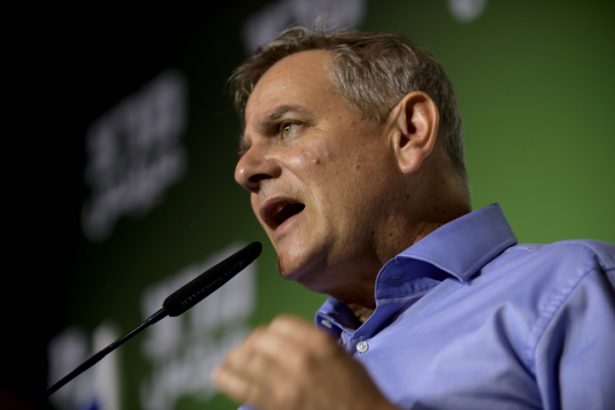

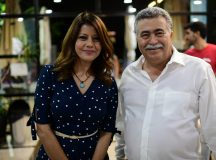
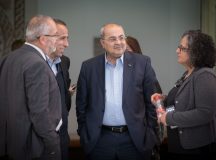
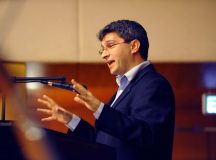
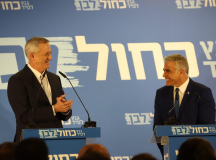































Comments are closed.